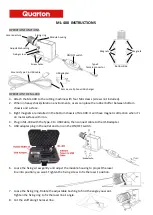
46
The FIFO data buffer is tested with two special write instructions. An
F16, A0 will write arbitrary 16 bit data into the buffer. An F16, A1 will
write the end of event tag into the buffer, and increment the event
counter. These two instructions allow one to fill the buffer with dummy
events. These can be read out over CAMAC, testing the entire data
path. If the ECLport is connected, these dummy events can be read out
through the model 4301/4302 memory system, testing that data path as
well.
EXTENDING THE
TIME RANGE
The Model 3377 has several features which make it possible to extend
the time range beyond the normal 32 microsecond full scale. The dead
time is short, 1.8 microseconds plus 200 nanoseconds per hit (double
word mode). The 4000 word multiple event buffer can hold up to 2000
hits (double word) or up to 31 events. The ECL port readout can transfer
data at 100 nanoseconds per word. The maximum number of hits per
channel is programmable, which allows one to absolutely limit the dead
time to read out the TDC chips into the buffer memory. There are at least
two basic methods (and many variations) of using these features to
extend the full scale time range.
Two 3377 TDCs can be operated alternately, in a ping pong mode, to
provide a continuous, deadtimeless, time stamping TDC. A 2366 univer-
sal logic module can be programmed to supply a common stop alter-
nately to the two 3377 modules, at 32 microsecond intervals. Identical
input signals are provided to both 3377 TDC modules. The maximum
number of hits is set to limit the total to less than 150 (300 data words).
For example, 4 hits per channel if all 32 channels are used, or 16 hits
per channel if 9 or fewer channels are used. The dead time to buffer an
event (a common stop) is then less than 32 microseconds (while input
data is being recorded by the other module). Each 3377 can store 31
events (or 4000 data words), for a total of nearly 2 milliseconds of
recording. Each event consists of the header and up to 150 data hits,
allowing simple reconstruction of the absolute time by counting headers.
If the ECLport is used to remove the data from the 3377s, the recording
time is limited only by the external memory buffer. For example, using a
4302 FERA memory, the system can record 2.4 milliseconds at the full
data rate, or up to 0.5 second at a low hit rate.
If the experiment requires recording times of bursts of events which have
a minimum time separation of at least a few microseconds between
bursts (for example, a period measurement), and therefore can tolerate
a small dead time to record each event, a long time range can be
provided using only one 3377 and one 2366 universal logic module. The
2366 can be programmed to use the 3377 trigger outputs to create a
common stop trigger when an event occurs. The 2366 also provides a
16 bit counter, counting a 100 kHz clock.
There are two ways to record this counter value with each event. The
first method creates a bit pattern using 16 TDC inputs. The 16 bit
counter word is strobed after each count, to provide a pulse pattern
(each ‘1’ bit produces a pulse) which is sent to sixteen of the 3377
inputs. The 3377 maximum time range is set to 11 microseconds. This
ensures that at least one counter pattern is recorded along with each



































